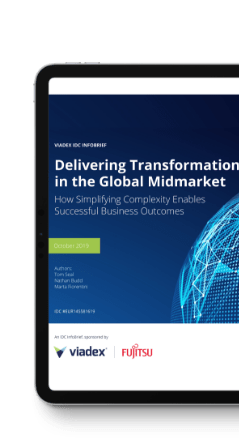Private Equity Investments and the Technology Backbone

by
Dave Rogers, a Viadex guest contributor, from Diligent Consultancy
‘Transformation’: What every investor looks for
Potentially, an investment company may lack the experience and insight in certain highly specialised areas of the due diligence process; one such area being the complexity of robust data security, along with the systems and governance that ensure it. In such instances the need arises to call in specialists to evaluate current state of play within an investment lifecycle, and to align the target organisation’s culture, processes and systems with identified success criteria, and eventually prepare for exit.
It is a process of transformation. While competitive advantage and revenue growth potential define the operational strategy, IT is its backbone. Ensuring that all is in order on the technology front depends on understanding what the definition of ‘order’ is when it comes to IT.
Pre-, during, and post-investment focus areas
Creation or consolidation of the essential IT backbone also depends on robust foundations for a strategic roadmap that will identify any changes required and drive value – within a specified timeframe that runs from pre-investment due diligence, to progressive operational efficiency gains during the lifetime of the investment, and on to preparation for exit.
Diligent Consultancy have worked with numerous organisations through this investment lifecycle where IT due diligence has not only identified areas for remediation, but has triggered fundamental re-thinks that have notably enriched the potential of the investment.
This has been achieved by adopting more than a ‘trouble-shooting’ approach and building a strategy that can be applied progressively as the investment moves forward, adding a service ‘wraparound’ to turn theory into practice and accelerate the process of operational improvement. It is a four-step approach:
Review | Refine | Remediate | Return
The benefits and value of each of those stages are:
- Review
In the initial phase of the investment life cycle, and an essential part of due diligence, obtaining clarity on costs and controls on software licences is imperative. This is primarily about revealing any wastage and unnecessary costs that might be occurring in the business. Investors need to know they are investing in a maturing business that effectively manages Microsoft Office 365 licences and does so in line with regulatory controls. Getting this right creates a quick win by correcting errors and inconsistencies from the past.Diligent Consultancy have worked with Viadex at this phase, and through the investment lifecycle, on many occasions. Viadex provide an effective tool known as the SPOT report, which identifies all existing Microsoft Office 365 users and licences and flags up any licence shortfalls and operating cost investment required. Red flags can also be raised for other areas of the IT ecosystem.
Viadex have undertaken an analysis of 15 companies for whom it has implemented the SPOT report, which showed it had achieved 19% average savings on cloud licensing, and 18.1% on software licensing. In the latter case this equated to savings of £1.5 million against an aggregate spend of £8.35 million.
- Refine
It is rare that the current processes in a business will be 100% top-of-the-range best practice. It is even rarer that this situation has arisen from incompetence. It is more likely to have come about as a result of the incumbent principals’ single-minded focus on building the idea or the compelling competitive advantage on which the business was founded.The principals are likely to have been outward focussed rather than inward; delivering benefits to their customers in a determined fashion. This may occasionally have led to their having their eyes off the ball in matters of internal systems and processes.
The investment/acquisition moment is a time for all to take a step back and reflect, addressing issues which may have inadvertently been dropped off the priority agenda.
This is where a gap analysis will provide invaluable foundations for the 100-day plan. It may point to the need for contracts with external parties to be reviewed to identify areas for cost reduction, optimise data security, and assess where the organisation sits in terms of digital transformation maturity.
- Remediate
Where any of the foregoing considerations raise doubts is where the weaknesses should be addressed. This is a complex task involving the compilation of a detailed strategic roadmap, with the twin objectives of rapid creation of a workable remediation plan and the identification of further digital transformation opportunities. Critical questions invariably arise in the area of cybersecurity:– Is a security strategy in place?
– Do you know and understand the current challenges?
– How well prepared is the business in the event of a cyber breach?The strategic roadmap effectively becomes the scope of works. Here’s the ‘pivot point’; whose scope is it? You can’t rely on external providers with whom existing contracts may well be part of the identified gaps; an independent view is essential. For this reason, private equity firms are increasingly turning to the engagement of fractional CTOs or CIOs – providing an on-demand and flexible service – with the depth of experience to evaluate the IT landscape of an investment target from end to end.
- Return
At the very least six months before exit, the investment management team should take a long objective look at the shape the business is in; as if it were being freshly assessed as a new investment target. Is it now solidly future-proofed? Completing an exit IT Due Diligence will deliver a smooth exit transition, providing a clean bill of health and ensuring valuation on exit is met.
No room for slippage
Technology should be top of the action list in any private investment, since it offers so much gain while potentially concealing so much that could go wrong. As much as tech is the true enabler of the age, it only takes a little slippage at the due diligence stage and onwards to allow it to disable the business.
Look more closely at the concept of CIO/CTO as a Service to get you in a safe place and help set you on the road to realising the potential you know is there.
Dave is the owner of Diligent Consultancy, a leading IT consultancy company serving the private equity sector in ensuring the valuation, and enhancing the intrinsic value, of investments. Dave supports Viadex in the delivery of our CIO as a Service.




